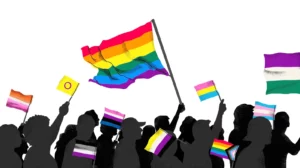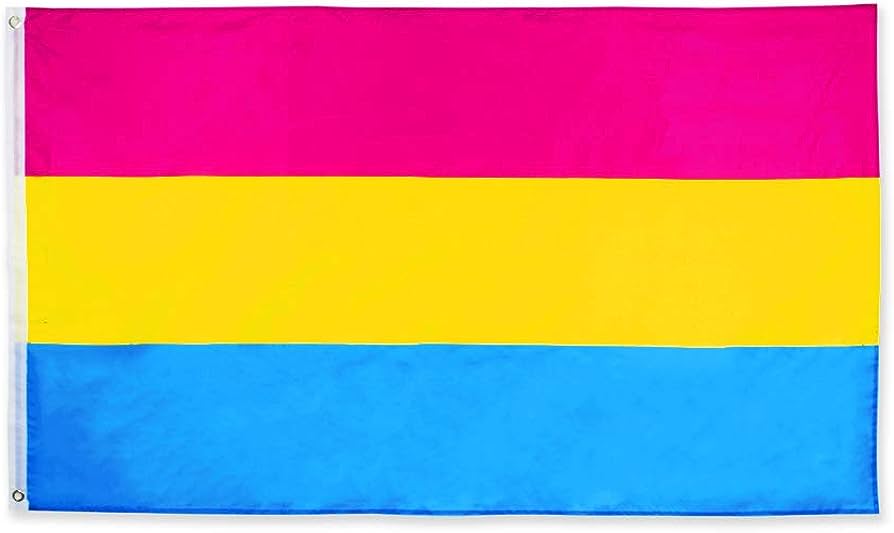Pansexual Flag is a colorful representation that goes beyond the conventional bounds of love and attraction. This flag, with its unique combination of pink, yellow, and blue stripes, serves as a vibrant beacon for those who identify as pansexual, embodying an all-encompassing love that is not limited by gender or biological sex. Our exploration of this meaningful symbol will guide us through its history, symbolism, and significance within the LGBTQ+ community and beyond.
Contents
Understanding Pansexuality
 Understanding pansexuality requires broadening traditional perspectives on sexual orientation to encompass more than the typical binary concept of male and female. Pansexuality is derived from the Greek prefix “pan-“, meaning all. It implies the capability of experiencing sexual, romantic, or emotional attraction to any person, regardless of their gender identity or biological sex.
Understanding pansexuality requires broadening traditional perspectives on sexual orientation to encompass more than the typical binary concept of male and female. Pansexuality is derived from the Greek prefix “pan-“, meaning all. It implies the capability of experiencing sexual, romantic, or emotional attraction to any person, regardless of their gender identity or biological sex.
This includes attraction to those who identify as male or female. As well as those who fall within the non-binary spectrum, such as genderqueer, genderfluid, androgynous, bigender, and more. Pansexuality appreciates love and attraction as boundless. Eventually, enables a vast and inclusive spectrum of potential relationships.
While pansexuality and bisexuality may seem similar, they are distinct in their approach to attraction. Bisexuality typically encompasses attraction to two or more genders. In contrast, pansexuality inherently acknowledges and accepts all gender identities, without any bias or preference.
What Is The History Of Pansexual Flag?
The pansexual flag emerged from the online platforms of the LGBTQ+ community around the year 2010. The precise individual or group who first designed and popularized the flag is not well-documented, reflecting a common trait among many pride flags whose origins often arise organically from the grassroots levels of communities.
This tri-colored flag was created as a distinct symbol to represent the pansexual community separately from the bisexual community. And addressing the frequent confusion and overlap between these two identities. While the Bisexual Pride Flag had existed since 1998, the Pansexual Pride Flag catered to a community with a more inclusive definition of attraction. And breaking the constraints of the gender binary.
The Pansexual Pride Flag consists of three horizontal stripes: pink at the top, yellow in the middle, and blue at the bottom. Each color is symbolic of the potential spectrum of attraction for pansexual individuals. The pink represents attraction to women, the blue attraction to men, and the yellow attraction to non-binary and gender-nonconforming individuals.
What Is The Symbolism of the Pansexual Flag?
 The Pansexual Pride Flag is a tri-colored banner. Each color represents a distinct facet of pansexual attraction. Designed to encompass the broad scope of pansexuality, the colors symbolize the potential for attractions that are not limited by the conventional binary understanding of gender.
The Pansexual Pride Flag is a tri-colored banner. Each color represents a distinct facet of pansexual attraction. Designed to encompass the broad scope of pansexuality, the colors symbolize the potential for attractions that are not limited by the conventional binary understanding of gender.
- The top stripe of the flag is colored pink. This symbolizes attraction to those who identify as women. This includes cisgender and transgender women, further emphasizing the inclusivity integral to pansexual identity.
- The middle stripe is yellow. It symbolizes attraction to non-binary individuals. Non-binary people do not identify strictly as men or women and may identify as both, neither, or as another gender entirely. This category also encompasses those who are genderqueer, genderfluid, androgynous, bigender, and other non-binary identities. The yellow stripe, therefore, represents the breadth of gender diversity recognized and embraced within pansexuality.
- The bottom stripe is blue. This symbolizes attraction to those who identify as men, including both cisgender and transgender men.
The combination of these colors in the Pansexual Pride Flag reflects the very essence of pansexuality: an attraction that transcends traditional boundaries of gender, recognizing and appreciating the full spectrum of gender identities. The flag serves as a visual embodiment of this inclusivity, acting as a beacon of recognition and pride for those who identify as pansexual.
What Is The Significance Of This Flag?
The Pansexual Pride Flag holds immense significance as a powerful symbol of identity, inclusivity, and visibility within the LGBTQ+ community and beyond.
- Identity
The flag serves as an emblem of personal and community identity for pansexual individuals, encapsulating the broad spectrum of their sexual and romantic attractions. It allows those who identify as pansexual to claim and display their identity openly, fostering a sense of belonging and unity.
- Visibility and Representation
Given the frequent misunderstanding and erasure of pansexuality, even within the LGBTQ+ community, the flag plays a critical role in increasing visibility and representation. By making pansexuality more visible, the flag helps to challenge stereotypes, misconceptions, and stigmas, educating the wider public about the existence and validity of pansexuality.
- Inclusivity
The flag underscores the inclusive nature of pansexuality. The unique color scheme symbolizes attraction to all genders, not just males and females but also those who identify as non-binary or gender-nonconforming. This inclusivity highlights and honors the diversity of human experiences with gender and attraction.
- Solidarity and Activism
In events such as pride parades or LGBTQ+ rights protests, the Pansexual Pride Flag is used to show solidarity and support for pansexual rights. It acts as a rallying symbol, uniting individuals under a common cause and amplifying the call for equality, and acceptance. And respect for all sexual orientations.
- Empowerment
Lastly, the flag serves as a tool of empowerment. Flying the Pansexual Pride Flag, whether in a parade, on a social media profile, or in any public or private setting. This can be a powerful act of self-affirmation and resistance against discrimination or prejudice.
In essence, the Pansexual Pride Flag is much more than a combination of colors. Rather, it’s a meaningful and dynamic representation of a diverse and vibrant community.
Role of the Pansexual Flag in LGBTQ+ Activism
 The Pansexual Pride Flag plays a significant role in LGBTQ+ activism. And serving as a symbol of recognition, unity, and resistance against discrimination. Here’s how it has contributed:
The Pansexual Pride Flag plays a significant role in LGBTQ+ activism. And serving as a symbol of recognition, unity, and resistance against discrimination. Here’s how it has contributed:
Advocacy and Visibility
The Pansexual Flag promotes awareness and understanding of pansexuality within the broader spectrum of the LGBTQ+ community and society at large. By raising the flag, activists shed light on pansexual identities, challenging misconceptions. And ensuring pansexuality is not erased or overshadowed by other sexual orientations. It underscores the existence and validity of pansexuality. Eventually, pushing for its recognition and acceptance.
Expression of Solidarity and Unity
During pride parades, protests, and other events, the Pansexual Flag is flown alongside other pride flags. And symbolizing solidarity among diverse sexual orientations and gender identities. The flag’s presence unifies pansexual individuals and allies, creating a sense of shared identity and purpose within the larger LGBTQ+ community.
Tool for Education
The Pansexual Flag serves as an educational tool in activism. The flag’s colors — pink, yellow, and blue — represent different aspects of pansexuality. It also provides a simple yet effective way to explain the nature of pansexual attraction to those unfamiliar with the concept. It creates an avenue for conversation and learning about the complexity and diversity of human sexuality.
Resistance and Empowerment
The act of raising the Pansexual Flag in public can be a powerful gesture of defiance against discrimination, prejudice, and homophobia. It serves as a symbol of resilience and empowerment for those who identify as pansexual, signaling their refusal to be silenced or marginalized.
Promotion of Inclusivity
By acknowledging and validating attraction to all genders, including non-binary and gender-nonconforming individuals, the Pansexual Flag sends a strong message of inclusivity. It pushes LGBTQ+ activism to continually broaden its understanding. And acceptance of diverse sexual and romantic orientations.
Overall, the Pansexual Pride Flag amplifies the voices of those who identify as pansexual. Also contributes to the overall goals of LGBTQ+ activism — promoting equality, acceptance, visibility, and the celebration of diversity.
Conclusion
In conclusion, the Pansexual Pride Flag stands as a vibrant symbol of love and attraction that transcends traditional gender boundaries. It is a beacon of inclusivity, recognizing and celebrating the full spectrum of gender identities. Its emergence and acceptance within the LGBTQ+ community and beyond testify to the ongoing evolution of understanding and expressing human sexuality.
As it waves high, it will continue to empower individuals to live their truth and contribute to the broader fight for equality and acceptance within the LGBTQ+ community and beyond. Life may sometimes be challenging for bisexuals, but Online Bisexual Counseling can help. Get experienced LGBTQ therapists at PrideMantra: Book a trial LGBTQ therapy session


